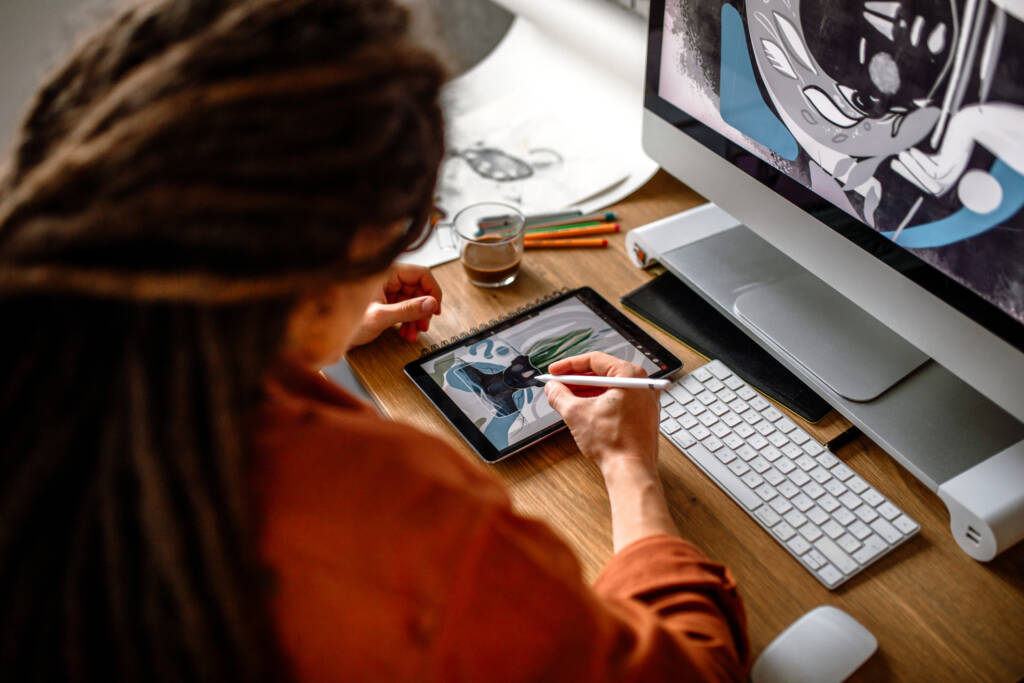
Digital Media Fundamentals 1a

Digital Media Fundamentals 1a: Introduction
Discover your talent for building digital media applications using text, graphics, animations, sounds, videos, and more! Learn about the elements that make impressive media, such as typography, color theory, design, and manipulation. Explore careers to apply your digital media skills and find your place in this fast-paced and exciting field!
During this course, you will learn career-related skills and earn a badge for this accomplishment. A badge is a digital certification of your career-related learning that you can share on social media and higher education platforms, or with colleges, potential employers, peers, and colleagues. Select this link to learn more about badges.
Major Topics and Concepts
Unit 1: Digital Media: Current Issues & Careers
Digital media is a 21st-century form of human communication. Although it is now part of everyday life through our use of cell phones and the internet, the technology needed for digital media to succeed wasn’t developed until the early 2000s. Since then, the field has grown exponentially, continually developing new and better ways to create and share ideas. Digital media professionals create in multiple formats (sound, images, animation, video, video games, web pages) and also assist in engineering and facilitating the networks where the media is disbursed to people around the world.
What will you learn in this unit?
Define digital media and understand key terms in the digital media field
Describe the evolution of media and the transition to digital
Describe the importance of the digital revolution
Explain the various challenges associated with creating and distributing digital
Identify and analyze digital media career opportunities
Unit 2: A Picture’s Worth a Thousand Words: Introduction to Digital Images
When snapping a selfie or taking pics of friends while out for a night on the town, we might quickly think about whether or not there’s enough light for the photo—but we don’t usually think about things like design and layout. However, as a professional media creator, you’ll start to pay a lot more attention to layout, design, perspective, and proportion, not only when you take photos, but anytime you create an image. It’s also important to understand the file types associated with different image files, why there are so many different kinds, and which software works best with each type.
What will you learn in this unit?
Distinguish file types and software associated with various digital image types
Determine the software programs best suited for creating and editing digital images
Identify and evaluate effective use of typography in digital images
Articulate an effective use of color theory in digital images
Outline basic principles of design and layout in digital images
Unit 3: Creating Digital Images: Photographs and Graphic Images
Many steps go into the process of creating a digital image. When you create digital photos, you plan the location of the photo shoot, design the layout, make decisions about lighting, models, costumes and props, and make sure you have all the right equipment. When you create graphic images, you’ll plan the design, locate and capture or download the graphic elements you’ll need to create it, know what software you want to use, and plan the layout, color, and typography to effectively meet the purpose for the image.
What will you learn in this unit?
Prepare for a photo shoot by determining purpose and considering specifics concerning location and light
Articulate specific concerns about design and layout to plan prior to shooting
Describe ways to execute a safe and successful photo shoot
Plan a graphic image
Unit 4: Editing and Distributing Digital Images
Creating a digital image is an important step, but it doesn’t usually complete the process—in most cases, you’ll need to enhance the image through editing, then decide how to package it for distribution. In order to gain expertise in editing digital images, you need to understand a few key terms and gain a deeper understanding of what a digital image is: a collection of data that tells your screen or printer how to simulate an image. It’s necessary to have a foundational knowledge of how digital images work in order to effectively use the editing tools for digital images. Next, you’ll choose image editing software and learn how to use the many enhancement tools that are available. You’ll have to know what type of image you’re creating and how it will be distributed in order to decide what type of software to use: a raster-based software for photos and photorealistic images or a vector-based software for images that are primarily text, layout, and graphic elements.
What will you learn in this unit?
Define and compare different uses for raster, vector, 2D, and 3D graphics
Identify basic photographic enhancement techniques and apply them to raster-based images
Design and enhance vector-based images
Differentiate and apply appropriate file types, resolution, and compression for editing, storage, and distribution of digital image files
Unit 5: Creating Animations
The first animation was created a little over 100 years ago. For the first 80 years of animation history, creating an animation was a very slow and painstaking process. When computers entered the animation scene in the 1990s, the process became easier and faster. Not only that, computers have allowed artists to create new tools and formats that keep improving the quality of animation and how we use it to communicate. In this unit, you’ll learn about the history of animation, explore the different animation formats, and get to know some of the software platforms used to create them. You’ll also create a few simple animations, including presentation slide animations, an animated GIF, and a short animated video.
What will you learn in this unit?
Define animation and describe its historical development
Explore professional tools for creating animations
Differentiate animation formats and how to effectively use them in digital media
Create animations for use in web sites and multimedia presentations
Unit 6: Digital Video—Pre-Production
Creating a professional digital video is not something you can do quickly or without planning. Before the shoot, you must consider the purpose of the video—its message— and how you will create images, sound, and other elements within the video to meet that purpose. This includes understanding the language of film (how your video will communicate through images) and how viewers interpret visual communication. In this unit, you’ll learn about the tools professional film and video makers use during the pre-production phase: storyboards to plan each shot, Gantt-type charts for production schedules, and equipment lists to make sure that when the shoot begins everyone has what they need to make it successful.
What will you learn in this unit?
Demonstrate understanding of film and video terminology
Understand how to effectively use framing, camera angles, and camera movement in a digital video
Describe the benefits of storyboards and create a storyboard for a digital video
Prepare for a video shoot by making a production plan and equipment list
Unit 7: Digital Video: Production and Post-Production
Once the pre-production phase is complete and you have a storyboard, you’re ready to start the process of principal photography—the production phase of film and video creation when you, your actors, and your crew go to each location and shoot footage. In the thick of the shoot when everything happens really fast, the time you spent in pre-planning will definitely pay off. When principal photography has ended, you’re ready for synching, editing, adding effects, and preparing for distribution—this is called post-production. The production phase of Hollywood films usually takes about two months and post-production takes anywhere from four months to three years. In this unit, you’ll experience a much simpler (and shorter) production and post-production process.
What will you learn in this unit?
Describe the elements of an industry standard video production
Conduct a video shoot
Edit a video
Export and distribute your video files
Unit 8: Putting it All Together: Multimedia Presentations
If you search the internet with this question—‘how many PowerPoints are delivered each day?’—you’ll get some pretty staggering results: about 35 million presentations are given every day to around 500 million people. In terms of time and productivity, that equals about $250 million per day. The technology for PowerPoint and other digital presentations has only been around for about 30 years, but in that time, it has taken root in our culture. It’s a good bet that you’ve seen your share of PowerPoints already because digital presentations are everywhere in education. As a digital media professional, you’ll learn how to avoid the boring “death by PowerPoint” and instead create presentations that effectively accompany and help to deliver your message.
What will you learn in this unit?
Determine the software programs best suited for creating and editing digital presentations
Create effective design and layout of text and images in a digital presentation
Create effective transitions and add multimedia elements to a digital presentation
Incorporate multiple elements into a digital presentation that uses good design principles and communicates its message effectively
Course Materials
Required Materials:
- Word processing software (Microsoft Word, Google Docs, etc.)
- Google Drive
- Google Slides
- Vecteezy account
- Powtoon account
- Canva account
- GIMP or Adobe Photoshop
- optional: iMovie or WeVideo
- optional: YouTube account
Competencies
Digital Media
Students will demonstrate an understanding of the digital media revolution by summarizing the historical impact of digital media, explaining the challenges facing digital media, and describing digital media careers.
Elements of Digital Images
Students will demonstrate an understanding of elements of digital images by describing digital image file types, summarizing digital image software options, and explaining digital image design considerations.
Creating Digital Images
Students will demonstrate an understanding of animation by summarizing the evolution of animation, explaining the tools and formatting options, and creating an animation for use in web sites and multimedia presentations.
Editing and Distributing Digital Images
Students will demonstrate an understanding of editing and distributing digital images by describing types of graphics, explaining editing techniques for digital images, and describing digital image distribution considerations.
Creating Animations
Students will demonstrate an understanding of creating animations by summarizing the history of creating animation and describing creation tools for different types of animation.
Digital Video Pre-Production
Students will demonstrate an understanding of digital video pre-production by describing the characteristics of digital video and explaining digital video pre-production phase considerations.
Digital Video Production
Students will demonstrate an understanding of digital video production by explaining elements of digital video production and describing digital video post-production considerations.
Multimedia Presentations
Students will demonstrate an understanding of multimedia presentations by describing different multimedia presentation software and explaining strategies for creating engaging presentations.
